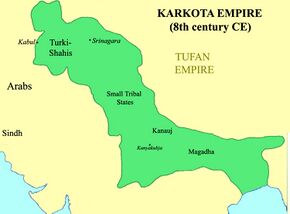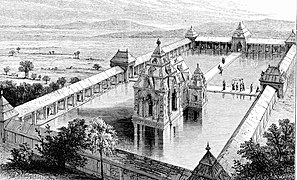History:Karkoṭa Empire
Karkota Empire | |||||||
|---|---|---|---|---|---|---|---|
| 625 CE–885 CE | |||||||
 Karkota territory at its maximum extent, according to Joseph E. Schwartzberg's A Historical Atlas of South Asia | |||||||
| Capital | Srinagar (625-724) Parihaspore (724-760) Srinagar (760-885)[citation needed] | ||||||
| Religion | Hinduism | ||||||
| Government | Monarchy | ||||||
| Samraat (Emperor) | |||||||
| Historical era | Classical India | ||||||
• Established | 625 CE | ||||||
• Disestablished | 885 CE | ||||||
| |||||||
| Today part of | |||||||
Karkota Empire (c. 625 - 885 CE) was a major power from the Indian subcontinent; which originated in the region of Kashmir.[1] It was founded by Durlabhvardhana during the lifetime of Harshavardhan. The dynasty marked the rise of Kashmir as a power in Northern India.[2] Avanti Varman ascended the throne of Kashmir on 855 A.D., establishing the Utpala dynasty and ending the rule of Karkota dynasty.[3]
Lalitaditya Muktapida, the dynasty's strongest ruler captured parts of Central Asia, Afghanistan and Punjab with Chinese help.[4] According to Kalhana's Rajatarangini, Lalitaditya was able to extend the power of Kashmir beyond the normal mountain limits and in about 740 AD inflicted a defeat upon Yashovarman, the King of Kannauj. Lalitaditya was able to vanquish the Turks, Tibetans, Bhutias, Kambojas and others.
The Karkota emperors were primarily Hindu.[5] They built spectacular Hindu temples in their capital Parihaspur.[6][7] They however also allowed Buddhism to flourish under them. Stupa, Chaitya and Vihara can be found in the ruins of their capital. Martand Sun Temple in the Anantnag district were built by Lalitaditya. It is the oldest known Sun temple in India and was also one of the biggest temple complexes at the time.[8]
Notes
- ↑ Life in India, Issue 1. https://books.google.ca/books?id=OjT4BQAAQBAJ&lpg=PA40&dq=Karko%E1%B9%ADa%20Empire&pg=PA40#v=onepage&q=Karko%E1%B9%ADa%20Empire&f=false.
- ↑ Kalhana (1147-1149); Rajatarangini.
- ↑ Sen, Sailendra Nath (1999). Ancient Indian History and Civilization. New Age International. p. 295. ISBN 978-8122-411-98-0.
- ↑ Wink 2002, p. 243.
- ↑ Kamlesh Moza. "Prominent Holy Places in Kashmir". http://www.koausa.org/Temples/martand.html.
- ↑ Animals in stone: Indian mammals sculptured through time By Alexandra Anna Enrica van der Geer. pp. Ixx. https://books.google.com/books?id=oQ3quxh9gsgC&pg=PR70.
- ↑ India-Pakistan Relations with Special Reference to Kashmir By Kulwant Rai Gupta. pp. 35. https://books.google.com/books?id=mksji5FVKwsC&pg=PA35.
- ↑ The Hindu-Buddhist Sculpture of Ancient Kashmir and its Influences. https://books.google.com/books?id=yVft0FqSxc0C&printsec=frontcover&dq=Karko%E1%B9%ADa+Empire&hl=en&sa=X&ved=0ahUKEwjS9Le51bHKAhXDdT4KHUMkAT0Q6AEINjAD#v=onepage&q=karkota&f=false.
References
- Wink, André (2002), Al-Hind, the Making of the Indo-Islamic World, 1, BRILL, ISBN 9780391041738, https://books.google.com/books?id=g2m7_R5P2oAC&pg=PA243
- Chadurah, Haidar Malik (1991), History of Kashmir, Bhavna Prakashan, https://books.google.com/books?id=nTFuAAAAMAAJ
- Hasan, Mohibbul (1959), Kashmir Under the Sultans, Aakar, ISBN 9788187879497, https://books.google.com/books?id=EUlwmXjE9DQC&&pg=PA2




